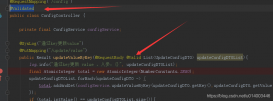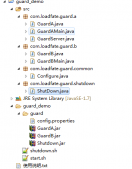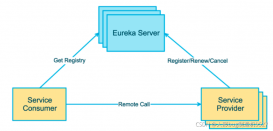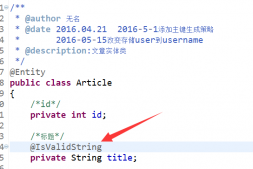1、应用场景:
如果项目中用到json字符串转为jsonObject的需求,并且,需要保证字符串的顺序转之前和转成jsonObject之后输出的结果完全一致。可能有点绕口,下面举一个应用场景的例子。
在做项目的过程中,需要写Junit单元测试,有一个方法如下:
|
1
2
3
4
5
6
7
8
9
10
11
12
13
14
15
16
17
18
19
20
21
22
23
24
25
26
27
28
|
@Test@SuppressWarnings("unchecked")public void facilitySoftwareQueryByPageExample() throws Exception { facilitySoftwareRepository.deleteAll(); FacilitySoftwareConfig facilitySoftware = createFacilitySoftware(); facilitySoftwareRepository.save(facilitySoftware); String userId = "1"; int pageNumber = 1; int pageSize = 5; String facilities = objectMapper.writeValueAsString(facilitySoftware); LinkedHashMap<String, Object> jsonMap = JSON.parseObject(facilities,LinkedHashMap.class, Feature.OrderedField); JSONArray jsonArray = new JSONArray(); JSONObject jsonObject = new JSONObject(true); jsonObject.putAll(jsonMap); jsonArray.add(jsonObject); this.mockMvc .perform(get("/v1/facilitysoftware/userid/" + userId + "/page/" + pageNumber + "/pagesize/" + pageSize + "")) .andExpect(status().isOk()).andExpect(jsonPath("content",is(jsonArray))) .andExpect(jsonPath("totalPages", is(1))) .andExpect(jsonPath("totalElements", is(1))) .andExpect(jsonPath("last", is(true))) .andExpect(jsonPath("number", is(0))) .andExpect(jsonPath("size", is(5))) .andExpect(jsonPath("numberOfElements", is(1))) .andExpect(jsonPath("first", is(true))) .andDo(document("facilitySoftware-query-example"));} |
例子就在这里:
|
1
|
.andExpect(status().isOk()).andExpect(jsonPath("content",is(jsonArray))) |
大家应该都能读懂,这行代码意思就是你用Api获取到的json字符串和你定义的字符串是否一致,一致则该条件测试通过。
这里的比较不仅仅要求所有的key和value都相同,而且需要保证两个json串的顺序完全相同,才可以完成该条件的测试。
查了资料解决途径过程如下:首先我们使用的是阿里的fastJson,需要引入fastJson的依赖,具体百度maven仓库,注意这里尽量使用稳定版本的较高版本。如 1.2.*
在解决问题过程中,遇到如下解决方案
1、在初始化json对象的时候加上参数true,这里不完全符合我们的需求,加上true之后,是让json串按照key的hashcode排序。
可以自定义升序或者降序,因为解决不了该场景的问题。这里不赘述,自行百度。
|
1
|
JSONObject jsonObject = new JSONObject(true); |
2、解决问题,代码如下,第一个参数是需要转换的json字符串。
|
1
|
LinkedHashMap<String, Object> jsonMap = JSON.parseObject(facilities,LinkedHashMap.class, Feature.OrderedField); |
|
1
2
3
4
|
JSONArray jsonArray = new JSONArray(); JSONObject jsonObject = new JSONObject(true); jsonObject.putAll(jsonMap); jsonArray.add(jsonObject); |
补充:JSON 序列化key排序问题和序列化大小写问题
1. JSON 序列化key排序问题(fastjson)
|
1
2
3
4
5
6
7
8
9
10
11
12
13
14
15
16
17
18
19
|
import com.alibaba.fastjson.JSONObject;import com.alibaba.fastjson.serializer.PropertyFilter;import com.alibaba.fastjson.serializer.SerializerFeature;//创建学生对象Student student = new Student();student.setName("小明");student.setSex(1);student.setAge(18);//序列化 json key按字典排序System.out.println(JSONObject.toJSONString(student ,SerializerFeature.MapSortField));//过滤不要的key age System.out.println(JSONObject.toJSONString(student , new PropertyFilter() { public boolean apply(Object source, String name, Object value) { if ("age".equals(name)) { return false; } return true; } }, SerializerFeature.MapSortField)); |
2. JSON 序列化大小写问题(fastjson)
|
1
2
3
4
5
6
7
8
9
10
11
12
13
14
15
16
17
18
19
20
21
22
23
24
25
26
27
|
//学生类import com.alibaba.fastjson.annotation.JSONField;public class Student { private String name; private Integer sex; private Integer age; @JSONField(name = "Name") //用于序列化成json,key Name public String getName() { return name; } @JSONField(name = "Name") 用于json(Name)反序列化成学生对象 public void setName(String name) { this.name = name; } public Integer getSex() { return sex; } public void setSex(Integer sex) { this.sex = sex; } public Integer getAge() { return age; } public void setAge(Integer age) { this.age = age; }} |
3. jackson 序列化大小写问题
@ResponseBody和@RequestBody中的序列化和反序列化就是用的jackson
|
1
2
3
4
5
6
7
8
9
10
11
12
13
14
15
16
17
18
19
20
21
22
23
24
25
26
27
28
29
30
31
32
33
34
35
36
37
38
39
40
41
|
//学生类import com.fasterxml.jackson.annotation.JsonProperty;public class Student { @JsonProperty("Name") private String name; private Integer sex; private Integer age; public String getName() { return name; } public void setName(String name) { this.name = name; } public Integer getSex() { return sex; } public void setSex(Integer sex) { this.sex = sex; } public Integer getAge() { return age; } public void setAge(Integer age) { this.age = age; }}//自己测试下import com.fasterxml.jackson.databind.ObjectMapper;import org.junit.Test;@Testpublic void test() throws Exception{ Student student = new Student(); student.setName("小明"); ObjectMapper MAPPER = new ObjectMapper(); //jackson序列化 String json = MAPPER.writeValueAsString(student); System.out.println(json); //jackson反序列化 Student student2 = MAPPER.readValue(json, Student.class); System.out.println(student2.getName());} |
4. jackson 序列化null值的问题
fastjson序列化默认会去掉值为null的键值对
|
1
2
3
4
5
6
7
|
//在学生类上加上这个方式一:(已经过时的方法)import com.fasterxml.jackson.databind.annotation.JsonSerialize;@JsonSerialize(include = JsonSerialize.Inclusion.NON_NULL)方式二:import com.fasterxml.jackson.annotation.JsonInclude;@JsonInclude(JsonInclude.Include.NON_NULL) |
5. jackson 反序列化忽略多余的json字段
|
1
2
|
import com.fasterxml.jackson.databind.DeserializationFeature;MAPPER.configure(DeserializationFeature.FAIL_ON_UNKNOWN_PROPERTIES, false); |
6. jackson 序列化忽略多余的json字段
|
1
2
3
4
5
6
|
方式一:@JsonIgnoreProperties:该注解将在类曾级别上使用以忽略json属性。在下面的栗子中,我们将从albums的dataset中忽略“tag”属性;@JsonIgnoreProperties({ "tags" })方式二:@JsonIgnore:该注释将在属性级别上使用以忽略特定属性;get方法上@JsonIgnore |
7. jackson 常用注解
|
1
2
3
4
|
@JsonAlias("Name") 反序列化时生效private String name;@JsonProperty("Name") 反序列化和序列化都时生效private String name; |
以上为个人经验,希望能给大家一个参考,也希望大家多多支持服务器之家。如有错误或未考虑完全的地方,望不吝赐教。
原文链接:https://blog.csdn.net/weixin_39214304/article/details/80652931















